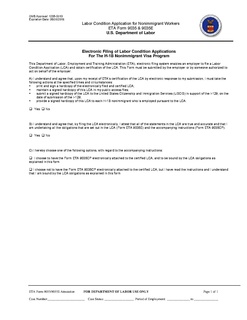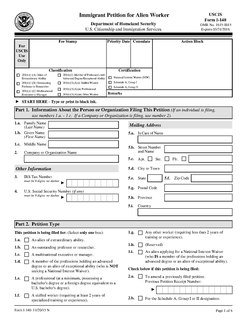The H-1B is a visa in the United States under the Immigration and Nationality Act, section 101(a)(15)(H) that allows U.S. employers to temporarily employ foreign workers in specialty occupations. A specialty occupation requires the application of specialized knowledge and a bachelor's degree or the equivalent of work experience. The duration of stay is three years, extendable to six years; after which the visa holder may need to reapply. Laws limit the number of H-1B visas that are issued each year: 188,100 new and initial H-1B visas were issued in 2019. Employers must generally withhold Social Security and Medicare taxes from the wages paid to employees in H-1B status.
An L-1 visa is a visa document used to enter the United States for the purpose of work in L-1 status. It is a non-immigrant visa, and is valid for a relatively short amount of time, from three months to five years, based on a reciprocity schedule. With extensions, the maximum stay is seven years.
TN status or TN visa is a special non-immigrant classification in the United States that offers expedited work authorization to a citizen of Canada or a national of Mexico, created as a result of provisions of the North American Free Trade Agreement that mandate simplified entry and employment permission for certain professionals from each of the three NAFTA member states in the other member states.
An H-2A visa allows a foreign national worker into the United States for temporary agricultural work. There are several requirements of the employer in regard to this visa. The H-2A temporary agricultural program establishes a means for agricultural employers who anticipate a shortage of domestic workers to bring non-immigrant foreign workers to the U.S. to perform agricultural labor or services of a temporary or seasonal nature. In 2015 there were approximately 140,000 total temporary agricultural workers under this visa program. Terms of work can be as short as a month or two or as long as 10 months in most cases, although there are some special procedures that allow workers to stay longer than 10 months. All of these workers are covered by U.S. wage laws, workers' compensation and other standards; additionally, temporary workers and their employers are subject to the employer and/or individual mandates under the Affordable Care Act. Because of concern that guest workers might be unfairly exploited the U.S. Department of Labor Wage and Hour Division is especially vigilant in auditing and inspecting H-2A employers. H-2A employers are the only group of employers who are required to pay inbound and outbound transportation, free housing, and provide meals for their workers. H-2A agricultural employers are among the most heavily regulated and monitored employers in the United States. Unlike other guest worker programs, there is no cap on the number of H-2A visas allocated each year.
An H-4 visa is a United States visa issued to dependent family members of H-1B, H-1B1, H-2A, H-2B, and H-3 visa holders to allow them to travel to the United States to accompany or reunite with the principal visa holder. A dependent family member is a spouse or unmarried child under the age of 21. If a dependent of an H-1B, H-1B1, H-2A, H-2B, or H-3 worker is already in the United States, they can apply for H-4 immigration status by filing Form I-539 for change of status with United States Citizenship and Immigration Services (USCIS).

A Form I-766 employment authorization document or EAD card, known popularly as a work permit, is a document issued by the United States Citizenship and Immigration Services (USCIS) that provides temporary employment authorization to noncitizens in the United States.
A J-2 visa is a non-immigrant visa issued by the United States for spouses and dependents of J-1 exchange visitors. Any J-2 visa with the Employment Authorization Document (EAD) can work for any employer in the US without sponsorship. 39.350 J-2 visas were issued in 2017.

The Labor Condition Application (LCA) is an application filed by prospective employers on behalf of workers applying for work authorization for the non-immigrant statuses H-1B, H-1B1 and E-3. The application is submitted to and needs to be approved by the United States Department of Labor Employment and Training Administration (DOLETA)'s Office of Foreign Labor Certification (OFLC). The form used to submit the application is ETA Form 9035.
The American Competitiveness in the 21st Century Act (AC21) was an act passed by the government of the United States in October 2000, pertaining to immigration to the United States. It was a complement to the American Competitiveness and Workforce Improvement Act that had been passed in 1998. The focus of AC21 was to change rules related to portability and caps for the H-1B visa to increase the effective number of visas available and make it easier for workers on those visas to switch jobs. Although the language of the Act references the Immigration and Naturalization Service (INS), the INS would soon be restructured and the functions of the INS referenced in AC21 would be handled by United States Citizenship and Immigration Services.
Premium Processing Service refers to an optional premium service offered by the United States Citizenship and Immigration Services to employers filing Form I-129 or Form I-140. To avail of the service, the employer needs to file Form I-907 and include a fee that is $1,500 for the H-2B and R classifications and $2,500 for all others.
The United States Citizenship and Immigration Services (USCIS) issues a number of forms for people to submit to them relating to immigrant and non-immigrant visa statuses. These forms begin with the letter "I". None of the forms directly grants a United States visa, but approval of these forms may provide authorization for staying or extending one's stay in the United States as well as authorization for work. Some United States visas require an associated approved USCIS immigration form to be submitted as part of the application.
Form I-539, Application to Extend/Change Nonimmigrant Status is one of the forms issued by the United States Citizenship and Immigration Services. It is used by people currently in the United States in a non-immigrant status to change the classification for their status and/or extend their stay with their current status. Both the current status and the status to which the transition is being sought must be non-immigrant visa statuses.
The National Visa Center (NVC) is a center that is part of the U.S. Department of State that plays the role of holding United States immigrant visa petitions approved by the United States Citizenship and Immigration Services until an immigrant visa number becomes available for the petition, at which point it arranges for the visa applicant(s) to take the visa interview at a consulate abroad. It is located in Portsmouth, New Hampshire. It was established on July 26, 1994 on the site of an Air Force base that was closed down by The Pentagon.
The Legal Immigration Family Equity Act of 2000, also known as the LIFE Act and as the Legal Immigration and Family Equity Act, along with its Amendments, made some changes to laws surrounding immigration for family members of United States citizens and Lawful Permanent Residents, as well as people eligible for employment-based immigrant visas, in the direction of making it easier for family members and immigrant workers to move to and adjust status within the United States. It was passed on December 21, 2000, as title XI of Pub.L. 106–553 (text)(PDF).
Special Immigrant Juvenile Status (SIJS) is a special way for minors currently in the United States to adjust status to that of Lawful Permanent Resident despite unauthorized entry or unlawful presence in the United States, that might usually make them inadmissible to the United States and create bars to Adjustment of Status. The key criterion for SIJS is abuse, neglect, or abandonment by one or both parents.

Form I-140, Immigrant Petition for Alien Worker is a form submitted to the United States Citizenship and Immigration Service (USCIS) by a prospective employer to petition an alien to work in the US on a permanent basis. This is done in the case when the worker is deemed extraordinary in some sense or when qualified workers do not exist in the US. The employer who files is called the petitioner, and the alien employee is called the beneficiary; these two can coincide in the case of a self-petitioner. The form is 6 pages long with a separate 10-page instructions document as of 2016. It is one of the USCIS immigration forms.
The term H-1B-dependent employer is used by the United States Department of Labor to describe an employer who meets a particular threshold in terms of the fraction of the workforce comprising workers in H-1B status. An employer classified as H-1B-dependent needs to include additional attestations in the Labor Condition Application used for the petition of any H-1B beneficiary being offered an annual compensation of less than $60,000 and without a master's degree. The notion was introduced by the American Competitiveness and Workforce Improvement Act (ACWIA) passed in 1998 and operationalized through the United States Department of Labor's Interim Final H-1B Rule of December 20, 2000. The regulation is found in 20 CFR 655.736 in the Code of Federal Regulations.
In the United States, the most common visa used for short-term trips is the B visa. This is a combination of the B-1 visa and the B-2 visa. People on B visas are generally not allowed to engage in productive work or study activities. However, in some cases, B visas can be issued that allow people to engage in some types of productive work and learning activity, in lieu of another visa. The three visa categories, for which a B visa could be issued instead, are the H-1B visa, H-3 visa, and J-1 visa. The U.S. Department of State recommends that consular officers clearly annotate such B visas to make the scope of the visa clear to the applicant and the U.S. Customs and Border Protection officer at the port of entry.
The H-1A visa was a visa that was previously available to foreign nationals seeking temporary employment in the United States. These visas were made available to foreign nurses coming into the United States to perform services as a registered nurse in areas with a shortage of health professionals as determined by the Department of Labor. The creation of this visa was prompted by the nursing shortage.
The R-1 visa is a non-immigrant visa which allows travel to United States for service as a minister or other religious occupation. Between October 2019 and September 2020, there were 2,399 R visas issued.


